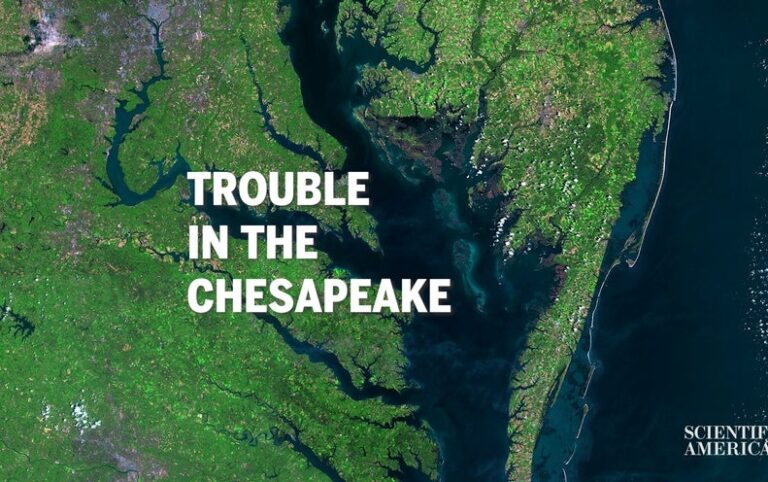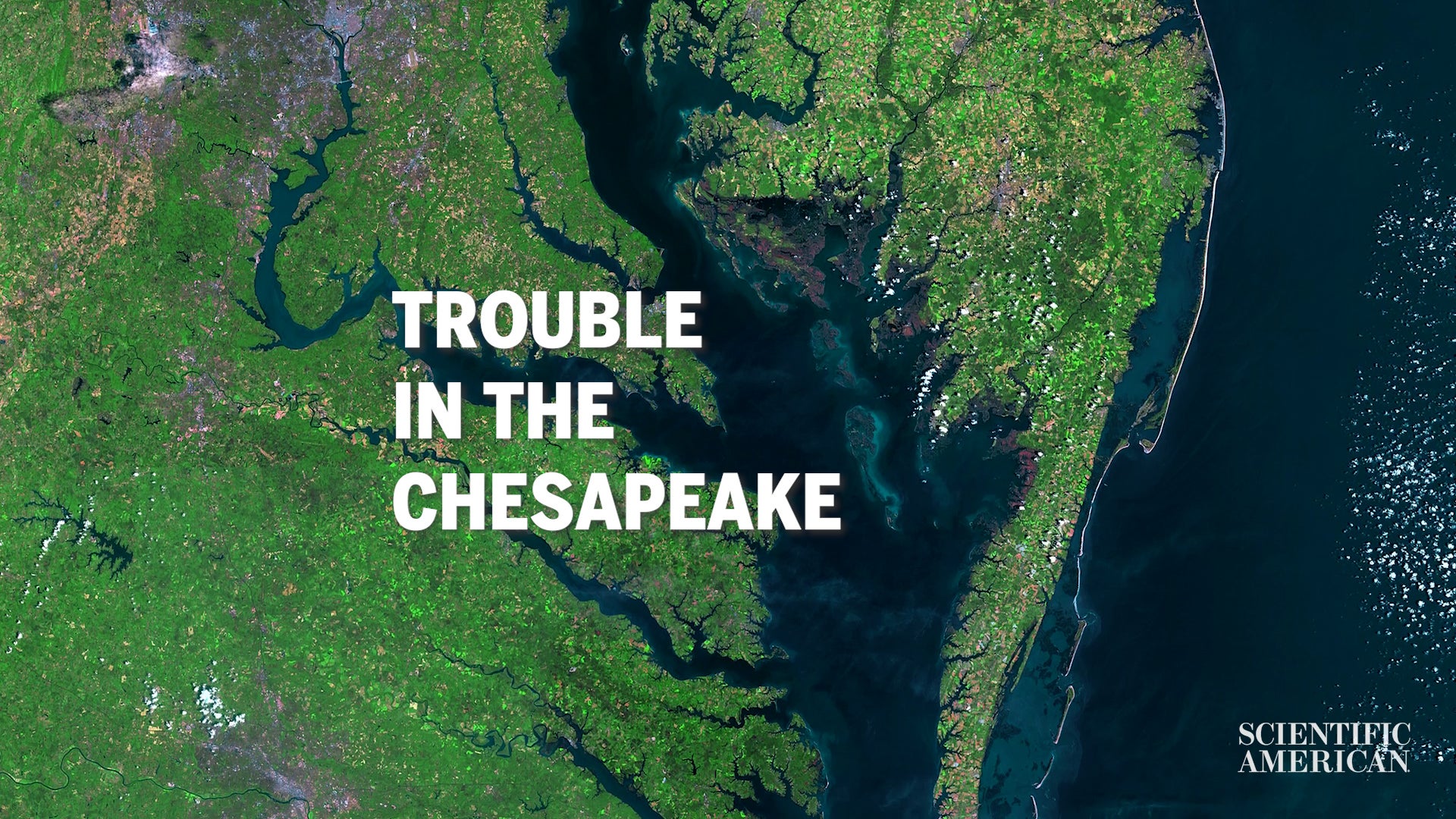
[ad_1]

In the 45,000 square mile Chesapeake Bay, the country’s largest estuary, nitrogen and phosphorus from wastewater treatment plants, and urban and agricultural run-off is continuously suffocating marine life.
“What happens in the Chesapeake Bay is not only important to our residents, but it also impacts seafood industries, recreation and commercial anglers all along the Atlantic Coast,” says Allison Colden, a senior fisheries scientist at the Chesapeake Bay Foundation, an independent conservation organization.
Despite decades of clean up efforts, and evolving regulations from the Environmental Protection Agency, the bay remains in a critical state. To make matters worse, climate change is compounding the region’s problems. Increased rainfall, which flushes more nutrients into the bay, and warming water temperatures is making it harder to reverse the damage already done to the bay.
This project was published in partnership with Baltimore Brew and partially supported by generous grants from the Pulitzer Center, the Society of Environmental Journalists, the Institute for Journalism & Natural Resources.
TRANSCRIPT
Narrator: Tom Weaver’s a charter boat captain. He’s been fishing these waters for more than 30 years.
Tom Weaver: It’s one of the best fishing spots in the world. It’s one of the nicest places to live in the world.
Narrator: The Chesapeake Bay is the country’s largest estuary. It spans over 4,500 square miles. More than double the size of Delaware. And it’s home to 10 million people and 3,600 species of marine life.
It is also an economic powerhouse, producing more than $33 billion in seafood, shipping and tourism each year.
But in the last decade, Weaver says finding fish for clients has become tougher than ever.
Weaver: Yeah, it’s, it’s, it’s harder. We’re burning more fuel.I can’t get some places without having to stop and refuel. I’ve seen a rapid decline in the overall population from the smaller size fish to the full breeding females.
A genuine concern for me is are we going to have enough fish to run a successful business? I can’t do this if there’s not any fish around.
Narrator: The fish in the bay are dying or moving, forced out by farm and city run-off, wastewater pollution, and climate change.
This body of water is fed by the Chesapeake Bay watershed. It spans 64,000 square miles across six states and DC. 73 percent of this area is public land.
But the watershed is also flanked by heavy polluters: factories, water treatment plants and big farms.
Elle Bassett: You can always kind of tell redhead from the others because of its distinctive leaves.
Narrator: Elle Bassett, a river conservationist, says 70 percent of the watershed she monitored when she worked at the non profit ShoreRivers was used for agriculture.
Bassett: Predominantly here on the Eastern Shore, we have row crop. So that would be corn, soybean.
We also have a large amount of chicken farms here on the eastern shore, particularly in the Delmarva area. And with that comes chicken litter, which is chicken poop, which is extremely high in nutrients as well.
Narrator: According to a 2021 report from the Environmental Integrity Project, a watchdog group, about 300 million chickens are raised on Maryland’s eastern shore every year.
Nitrogen and phosphorus are the main chemicals found in chicken manure and fertilizer. When heavy rains fall on farmlands, these nutrients wash into the bay. In 2021, according to Chesapeake Progress, a group that monitors the bay’s clean up, 260 million pounds of nitrogen and 15 million pounds of phosphorus poured into the bay. Nearly half were from farms.
Bassett: When we have excess nutrients entering our waterways, that nitrogen and phosphorus, it fuels the growth of those microscopic plants of that algae. Then what happens is you have this floating mat of green, brown, red mahogany, different types of algae that are then floating on the surface and multiplying.
Narrator: The algae eventually die and sink to the bottom of the bay. As they decompose, they starve the water of oxygen. This creates “dead zones,” which can lead to massive die-offs of marine creatures that are unable to escape these areas.
In 2021, the dead zone was 7 percent larger than the yearly average. And it lasted a month and a half longer.
The bay is the primary spawning and nursing ground for up to 90 percent of Atlantic striped bass. According to the National Oceanic and Atmospheric Administration, striped bass numbers are below sustainable levels here.
In 2022, the number of blue crabs in the Bay plummeted—the third year in a row of steep decline. In 2019, there were almost 600 million blue crabs. In 2022, there were less than 230 million. The lowest number in 33 years of tracking blue crab populations.
But agricultural pollution isn’t the only problem. On the western shore, stormwater runoff and pollution from wastewater treatment plants are feeding the bay’s dead zones.
The Back River and Patapsco River wastewater treatment plants are the two biggest in Maryland. But system-wide failures have caused these plants to spew even more nutrients and sewage into the bay.
Alice Volpitta: Based on our bacteria monitoring, we know that it is sometimes unsafe to come into contact with the water in the Back River.
Narrator: Alice Volpitta is a water quality scientist at Blue Water Baltimore. She says these treatment plants have discharged dangerous levels of nutrients, oils and bacteria since 2014.
Volpitta: One of the ways we test how healthy or sick the water is is with this instrument called a hydrolab. And so this instrument has different probes on it that tell us measurements of things like chlorophyll content, dissolved oxygen, temperature – all of the different measurements of chemistry that tell us, “Is this waterway achieving water quality standards?”
Narrator: In 2021, Blue Water Baltimore and the Chesapeake Legal Alliance sued Baltimore City under the Clean Water Act. It spurred Maryland to take over the Back River plant. The case is ongoing.
Since the 1960s, there have been several clean-up efforts across the bay. But none have been successful.
Bassett: It is really difficult to make change when thinking about the Chesapeake Bay, you have six states and D.C., that’s six different leaders, seven different leaders. All trying to think about solutions to the same problem.
Narrator: The most recent plan is the 2010 Chesapeake Clean Water Blueprint: a guide for each state to reduce nutrient pollution by 2025.
In October of 2022, the EPA confirmed that none of the bay states are on track to meet these pollution reduction goals. The EPA is considering pushing back the pollution deadline.
Adam Ortiz: Our job is to keep everybody together in a partnership and to hold each other accountable to the extent that we can, to make sure that we’re doing our part to make sure that the water is clean.
Volpitta: We’re seeing a chronic lack of enforcement of these clean water laws. And that’s a huge problem.
A good law without proper enforcement is a lion with no teeth.
Narrator: Without a way to stop nutrient pollution at the source, some organizations are trying to catch it once it enters the bay.
Bassett: A lot of people in the Chesapeake region will say, “If we can bring back the grasses, we can bring back the Chesapeake Bay.” Not only do they provide habitat, food, shelter, oxygen, but they also uptake nutrients.
Narrator: At ShoreRivers, Elle Bassett harvested and replanted underwater seagrasses yearly.
Bassett: We use volunteers to go out and scout for SAV beds.
Narrator: SAV stands for “submerged aquatic vegetation.”
Bassett: If it’s a healthy, robust, thick bed, then what we’ll do is we’ll harvest the seeds from that bed.
ShoreRivers Volunteer: So we’re going to mix these seeds in with the dry sand so that the seeds are evenly distributed.
Narrator: But time is running out. Climate change means wetter, more frequent storms are hitting the area, flushing more nutrients off farmlands and urban areas.
Stormwater runoff transports 17 percent of the nitrogen and phosphorus that enters the bay.
Another problem: water temperatures are rising. The Virginia Institute of Marine Science says summer temperatures in the bay have increased by 2 degrees Fahrenheit since the late 1980s.
Bassett: Hot water holds less oxygen than cool water. We’re stressing out our environment. We are causing more dead zones. And that not just we I mean that’s climate change that is having that impact.
Ortiz: It’s no surprise to any of us that restoring any water body, especially one as large and complicated as the Chesapeake Bay, is tough. It is unquestionably tougher with the challenges of climate change.
Weaver: This is a public resource. You, me, every person here has equal rights to the access to this, this bay, you know, and everything in it. Managing that resource is our responsibility as a group.
But the Chesapeake Bay is definitely savable. I mean, whether we’ll get it back to 400 years ago, unlikely, but it’s definitely – we can bring that back and 100 percent worth it.
[ad_2]